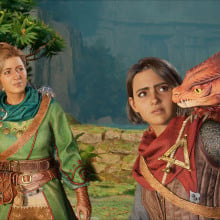Astronomers detected hundreds more new worlds beyond the solar system this year and worked to better understand what makes them tick.
The number of confirmed exoplanets — planets that don't orbit the sun — is up to 5,788, according to NASA, with thousands of additional candidates under review. All these worlds exist in our galaxy, though scientists believe they detected one planet outside the Milky Way in 2021.
Keep in mind the growing tally is a tiny sampling of planets in space. With hundreds of billions of galaxies, the universe probably teems with many trillions of stars. And if most stars have at least one orbiting planet — well, don't let your heads explode with the math.
No two alien planets are alike, each harboring its own distinct chemistry and conditions. There are water worlds, planets with multiple sunsets, volcanic worlds, rogue worlds, and planets with clouds unlike anything found in Earth's skies.
With the powerful James Webb Space Telescope, getting to know these worlds is getting easier. The leading infrared space observatory spends about a quarter of its time studying exoplanets. By analyzing another planet's atmosphere, scientists can tell a great deal about a world, including whether it could be hospitable to life.
Webb will soon begin a massive study of rocky worlds outside the solar system, specifically to discover if exoplanets orbiting near small cool stars could have air. The campaign, first reported by Mashable, will take a closer look at a dozen nearby-ish planets over the next two years.
Here are some highlights from the exoplanets studied over the past year.
A toxic stink-bomb of an exoplanet

Astronomers found a planet that probably reeks of burnt matches and rotten eggs, the odors associated with two gases identified in its atmosphere: sulfur dioxide and hydrogen sulfide. But no one's nose will likely ever get close to this world, 35 light-years away in the constellation Volans, to find out. The planet, L 98-59 d, likely has a molten or volcanic surface.
Earth's atmosphere is filled with nitrogen, oxygen, and traces of water vapor. Venus has a thick atmosphere of carbon dioxide, and Mars has a thin atmosphere of carbon dioxide. Based on the terrestrial worlds humans are familiar with, no one expected to find a similar type of planet with so much sulfur.
An exoplanet with a mysterious sibling
Tweet may have been deleted
A "super-Earth," a world somewhat larger than our own, orbits a star about 137 light-years away from the sun. What has intrigued astronomers about it is that it resides in the habitable zone around its small reddish star. The zone, sometimes referred to as the Goldilocks zone, is the region around a host star thought to provide the right surface temperature for liquid water to exist on a planet.
But perhaps even more exciting than this world, dubbed TOI-715 b, is its potential sibling: a smaller, more Earth-size planet. Scientists plan to study it as well.
A confirmed exoplanet at Barnard's star

Barnard's star, one of the closest stars to the sun, has been a target of exoplanet searches for over a century, with a storied past of false positives.
Scientists have finally found a world orbiting the star and confirmed it with multiple follow-up observations. They estimate this planet, Barnard b, to be about 20 times closer to its star than Mercury is to the sun, with a surface temperature of about 250 degrees Fahrenheit.
A tamer Venus-like exoplanet

Scientists say they've found the nearest temperate Earth-size world to date: Gliese 12 b, a so-called exo-Venus, meaning a rocky planet outside the solar system about the size of Venus.
"Temperate" and "Venus" may seem contradictory to those who know about Earth's neighbor. It's a hot, toxic planet, with sulfuric acid rain and volcanoes. Unlike the real Venus, which is about 900 degrees Fahrenheit because of a runaway greenhouse effect, researchers think Gliese 12 b's surface could be an average of 107 degrees.
A sauna-like exoplanet

A team of scientists are calling a new planet detection the first direct evidence of a "steam world" — that is, an exoplanet blanketed in wet heat.
The planet, GJ 9827 d, is about 100 light-years away from the solar system in the constellation Pisces. It's about twice the size of Earth and has an atmosphere almost entirely composed of water vapor. Before now, such worlds were only theorized.
A roiling half-lava exoplanet

Scientists found an exoplanet just a little larger than Earth, around a star much like the sun. But that's pretty much where the similarities end. The planet, HD 63433 d, is one-tenth Earth's age, exponentially hotter, and likely burbling molten lava on one side. A year on this world would fly by in just four Earth days.
This is considered the smallest and closest "young" exoplanet so far, at only 73 light-years away. Astronomers estimate it's about 400 million years old, which is ancient on a human timescale, but a mere whippersnapper compared to our 4.5 billion-year-old home planet.
An exoplanet that resembles an eyeball?

A new study revealed a small exoplanet could be an icy orb like Jupiter's moon Europa or have a liquid ocean about half the size of the Atlantic Ocean facing its star. If the latter were true, the water might even be a crisp 68 degrees Fahrenheit at the center.
The exoplanet, LHS 1140 b, is about 48 light-years away from Earth, in the constellation Cetus. Scientists believe it is probably rocky and could have other similarities to our planet.
A glowing terrestrial exoplanet

In a star system 66 light-years away, scientists spotted a world riddled with so many volcanoes, it would glow red-hot like campfire embers. A researcher even described the finding, HD 104067, as "Io on steroids," referring to the most volcanic world in our solar system, one of Jupiter's moons, Io.
HD 104067's robust volcanic activity is caused by two other nearby exoplanets exerting strong gravitational forces and distorting its orbit into an egg shape. All that squeezing and tugging generates heat and inner geological activity.
A very young exoplanet

This next exoplanet is a newborn baby. The huge planet, roughly 430 light-years away, is just 3 million years old.
Usually such nascent worlds are surrounded by debris, making them nearly impossible to observe. But astronomers got a window of opportunity with IRAS 04125+2902 b (yup, that's its name). Something — perhaps a companion star's gravity or a cosmic collision — has caused the disk to warp, revealing the planet in its infancy.
Right now the planet appears as wide as Jupiter but much lighter. Scientists think that means its atmosphere is inflated and will shrink down to a super-Earth or mini-Neptune as it matures.
A rocky exoplanet with an atmosphere?

When astronomers say they are on a quest to find a rocky planet with an atmosphere, they're not talking about mood lighting and soft jazz. They're looking for a world that resembles our own in a crucial way, and scientists say super-Earth 55 Cancri e might be the best bet: Temperature readings have revealed it's not as scorching hot as expected, perhaps because energy is being redistributed by an atmosphere.
NASA has called Earth's own atmosphere its security blanket. Without it, the type of life flourishing here wouldn't exist. It holds oxygen in the air, filters out ultraviolet radiation, and allows liquid water to pool on the surface.
This finding wouldn't mean 55 Cancri e, about 41 light-years away, is an exit plan for humans — far from it. Its orbit is so tight around its star, the world is probably covered in lava, with one side in constant darkness. Still, proof of an exoplanet with an atmosphere orbiting a red dwarf star would bode well for the idea that others are out there.
Want more of the best of 2024? Join Mashable as we look back at all the viral TikTok songs, internet slang, movies, memes, hyped up hardware, dating trends, social media apps, and more that have delighted and amazed us so far this year.
Topics NASA

















